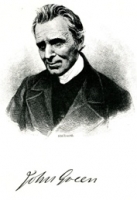Doctor John Green III
Founder of the Worcester Public Library
 Dr. John Green, III was born in Worcester on April 19, 1784. From the age of 6 he lived in the brick mansion built by his father, Dr. John Green, II, at 248-254 Main Street (opposite Central Street), just south of his office and apothecary shop. In 1849, a forward thinking Dr. Green, III had gas lamps put in, and in 1862 a bathtub was installed, following the repeal of a Massachusetts law that made bathing unlawful. Dr. John Green, III died in this home in1864 at the age of 81.
Dr. John Green, III was born in Worcester on April 19, 1784. From the age of 6 he lived in the brick mansion built by his father, Dr. John Green, II, at 248-254 Main Street (opposite Central Street), just south of his office and apothecary shop. In 1849, a forward thinking Dr. Green, III had gas lamps put in, and in 1862 a bathtub was installed, following the repeal of a Massachusetts law that made bathing unlawful. Dr. John Green, III died in this home in1864 at the age of 81.
Annexed to Dr. Green’s home, behind his apothecary shop, was an herb garden, and on Eden Street, an orchard for his beloved apple trees, which extended uphill to Harvard Street. This street was named for the college that gave him an honorary degree eight years after he began to practice medicine under his father’s tutelage in Worcester. In 1846 John Street, in that vicinity, was named for him. Green’s Lane, now Greenhill Parkway was named for the Green Family who settled there and later built a mansion on Green Hill.
Dr. Green’s early medical training was with his father. He did attend Brown University and later, in 1827, was awarded honorary degrees in medicine from both Harvard University and Brown University. He was the third generation of doctors to serve the people of Central Massachusetts. Dr. Green married Dolly Curtis, who died young and without children. He never remarried and continued to serve the people of Worcester until his death.
Stephen Salisbury once said of him, that his patients seem convinced that Divine Providence committed their lives to Dr. Green.
He is described as a striking figure, six feet tall, slight and stooping; eyes keen and observing. A small portrait of the young Dr. Green, painted in his 30s, hangs in the Worcester Public Library’s Board Room. The local newspaper wrote: “Not to have seen him under his brown broad-brimmed, soft felt hat as he rolled from side to side in that old gig was to miss one of the most striking institutions of Worcester,” and “The doctor’s gig, which has long been one of the 'institutions' of Worcester, and the characteristic dress and manner, the sight of which acted as tonic to the afflicted for nearly half a century.” (Mass. Spy October 18, 1865)
A larger portrait of an older Dr. Green hangs at the Tower Hill Botanic Garden, in Boylston, MA, in honor of his service as the first President of the Worcester County Horticultural Society and as a founding member of that organization. For him “horticulture was a special joy.” This portrait originally hung at Horticultural Hall in Worcester, now the home of the Worcester Historical Society.
In 1862, Dr. John Green was honored to be the first to cross the new causeway built over Lake Quinsigamond, replacing the old floating bridge that connected the Boston Post Road between Worcester and Shrewsbury. Doctor Green reportedly also owned a bathhouse on the lake and enjoyed rowing there as well. “At half past two yesterday afternoon Dr. John Green was first to cross the new road in his carriage. In honor of the event he furnished some refreshments to all the laborers present.” (Daily Spy June 28, 1862)
WORCESTER PUBLIC LIBRARY
Books and book collections were Dr. John Green, III's passion. The first books he purchased, as a student at Brown University, were the three volume set “Chambers Cyclopedia.” Dr. Green, II, his father, was quoted at the time as saying that it “looks like John is going pretty heavily into books.” He (Dr. Green, III) made purchases as opportunity offered on a well digested plan, so that his collection gradually developed itself in such proportions, that he was satisfied to open its treasures to the public in his lifetime.
During his lifetime he used at least four different bookplates. The oldest is labeled “Dr. John Green, physician, dentist, surgeon, apothecary and man-midwife,” with a border of 85 tiny drawings of skull and crossbones.
In 1855 Dr. Green gave 5,000 volumes of his extensive book collection to the Worcester Lyceum on a 5-year loan. As this loan period was about to expire in November of 1859, Dr. Green made known to the Directors of the Lyceum and to the Mayor of the City, his desire to endow a public library. The original donation of these 5,000 volumes and his promised donation of the remainder of his collection, over 7,000 additional volumes (valued at over $10,000) to the City of Worcester, was with the condition that the City “erect a suitable library building.” The new library was to hold these books “in trust for the free use of the citizens and public forever as a library of consultation and reference.”
The Library was established on December 23, 1859. The last of the books, which came to the new Worcester Public Library upon Dr. Green’s death in 1864, brought the total number of books to 12,000 volumes. In his will, Dr. Green left $30,000 to the City of Worcester as "an endowment for a department created by him in that institution." At his death Dr. John Green’s estate was valued at $175,000. The Dr. Green collection is now housed in the closed stacks of the Worcester Public Library.
"This Library (Worcester Public Library) is his offspring and his gift to all the people of Worcester."

